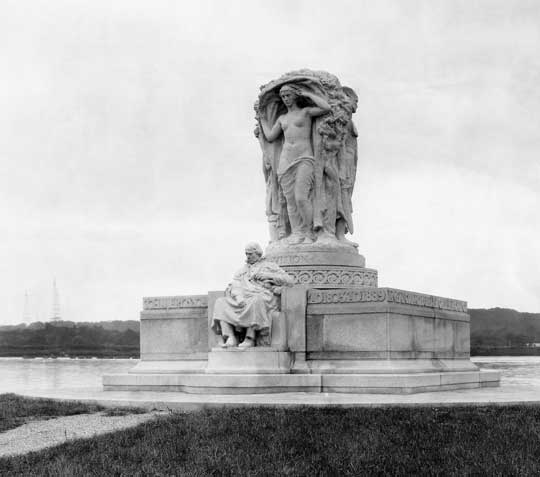
History of the Ericsson Memorial in Washington, D.C.
John Ericsson (1803-1889) was a Swedish-born naval engineer who emigrated to the United States in 1839. During the Civil War, he designed and supervised the construction of the ironclad Monitor for the Union navy, a ship that revolutionized naval warfare. As an inventor, he is best known for perfecting the screw propeller.

The Ericsson Memorial, c. 1930. Credit: Washingtoniana Division, D.C. Public Library.
This memorial to Ericsson is 820 feet south of the Lincoln Memorial, overlooking the Potomac River. Ericsson appears as a seated figure, seemingly deep in thought. Behind the figure is the tree Yggsdrasill, which, in Norse mythology, binds together the universe with its roots and branches. Three allegorical figures represent Ericsson's principal qualities: Vision, a woman peering into the distance; Adventure, a Norse warrior; and Labor, an American iron worker. The decoration on the base is Norse in inspiration.
The memorial was the work of sculptor James Earle Fraser. Best known as the designer of the American buffalo nickel, Fraser was responsible for The Arts of Peace and many other works of public sculpture in Washington, D.C. Congress authorized the Ericsson Memorial in 1916, and Swedish societies in America raised $25,000, almost half of the cost; Congress appropriated the remainder. Working from a full-sized plaster model provided by Fraser, a stone-cutting firm carved the allegorical figures on site from a 40-ton block of pink granite. The figure of Ericsson was carved from a second, 25-ton block.
When it was clear that the memorial would not be completed in time for its unveiling in 1926, the granite blocks were moved aside and replaced with the plaster model, painted pink to resemble stone. The ceremony could not be postponed because it was planned to coincide with a visit by Crown Prince Gustaf Adolf of Sweden. At the unveiling, held May 29, 1926, the crown princess pulled a cord, revealing the memorial to the crowd, accompanied by a 21-gun salute from a naval ship anchored in the Potomac. This was immediately followed by an address by President Calvin Coolidge. The memorial was completed a year later, in October 1927.
Adapted with permission from The Washington National Mall, by Peter R. Penczer, Oneonta Press, Arlington, Va.: 2007.
Copyright © Peter R. Penczer 2016